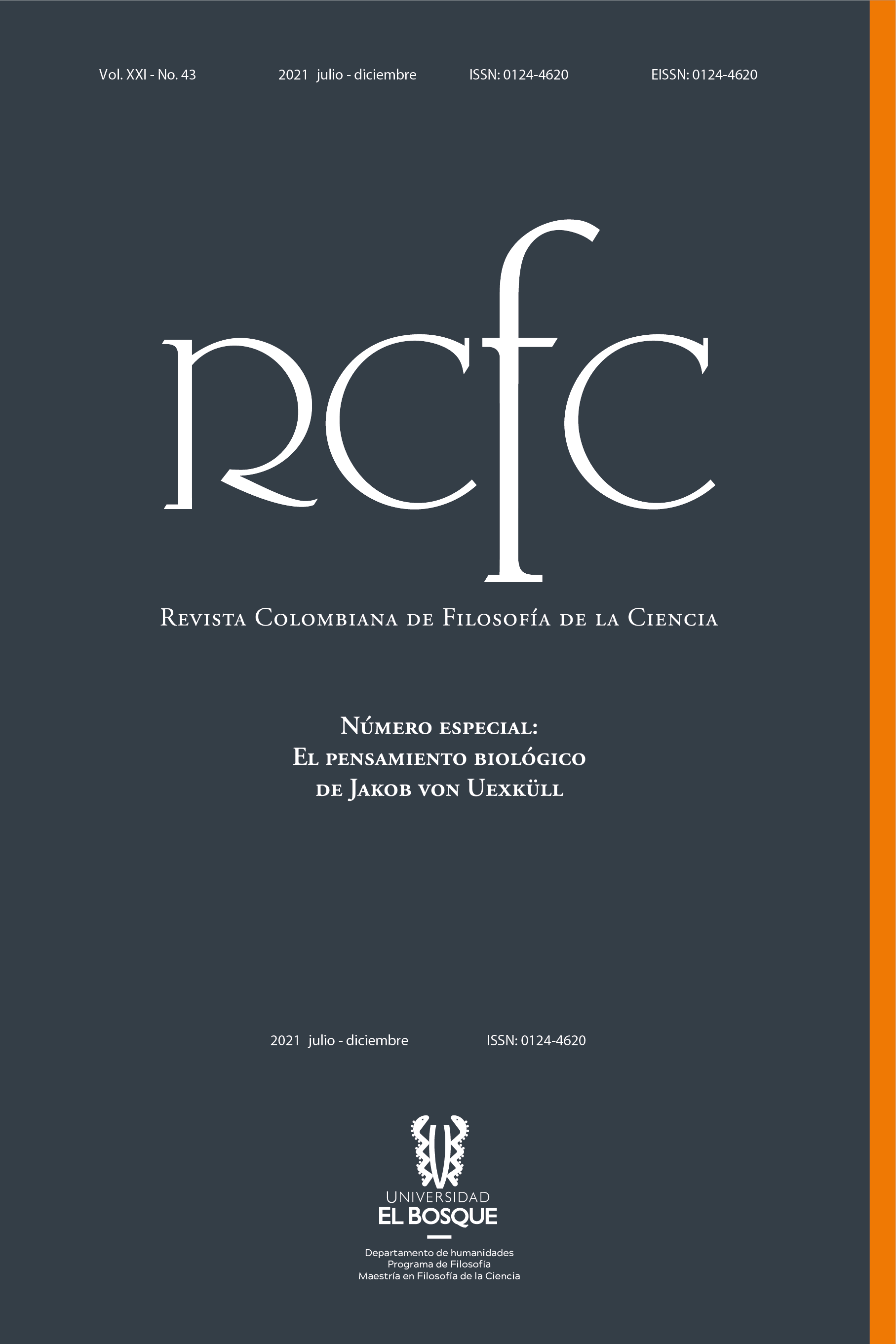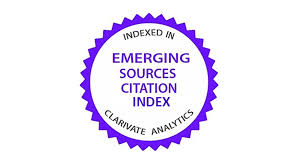Organización, experiencia y adaptación. Tres conexiones biosemióticas entre el pensamiento de von Uexküll y la biología enactiva de Maturana y Varela
DOI:
https://doi.org/10.18270/rcfc.v43i21.3365Palabras clave:
biosemi´ótica, círculo funcional, autopoiesis, Umwelt, acoplamiento estructuralResumen
Desde un enfoque biosemiótico —es decir, centrado en las maneras como el significado y la vida coemergen y se relacionan estrechamente— este artículo se propone establecer tres conexiones entre las teorías del biólogo estonio Jakob von Uexküll y las teorías de los biólogos chilenos Humberto Maturana y Francisco Varela. Tales conexiones surgen a partir de tres preguntas generales con respecto a la vida y la construcción de sentido en los organismos: la organización, la experiencia y la adaptación. Así, en el recorrido del texto se configuran puntos de cruce e ideas complementarias entre las teorías más salientes tanto de von Uexküll como de la biología enactiva de Maturana y Varela: principalmente, se establecen conexiones entre el concepto de ciclo funcional y la teoría de la autopoiesis; entre el Umwelt, o mundo-entorno, y la noción de mundo enactivo; y entre el contrapunto adaptativo y el acoplamiento estructural.
Descargas
Referencias bibliográficas
Andrade, Eugenio. “A semiotic framework for evolutionary and developmental biology”. Biosystems. 90.2 (2007): 389–404. Web. https://doi.org/10.1016/j.biosystems.2006.10.003
Barbieri, Marcello. The organic codes: An introduction to semantic biology. Cambridge, UK.; New York: Cambridge University Press, 2003. Impreso
–––. Introduction to biosemiotics: The new biological synthesis. Dordrecht, the Netherlands: Springer, 2008. Impreso.
Bateson, Gregory. Mind and Nature: A Necessary Unity. New York: Dutton, 1979. Impreso.
Bitbol y Luisi. “Autopoiesis with or without cognition: Defining life at its edge”. Journal of The Royal Society Interface. 1.1 (2004): 99–107. Web. https://doi.org/10.1098/rsif.2004.0012
Brentari, Carlo. Jakob von Uexküll the Discovery of the Umwelt between Biosemiotics and Theoretical Biology. Dordrecht: Springer Netherlands, 2015. Impreso.
De Jaegher, Rohde y Di Paolo. Enaction: Toward a New Paradigm for Cognitive Science. Cambridge; London: MIT Press, 2010. Impreso.
Deacon, Terrence. W. Incomplete nature: How mind emerged from matter. New York: W.W. Norton & Co, 2012. Impreso.
Di Paolo, Ezequiel. “Extended Life”. Topoi. 28.1 (2009): 9–21. Web. https://doi.org/10.1007/s11245-008-9042-3
Di Paolo y Thompson (2014). “The Enactive Approach”. The Routledge Handbook of Embodied Cognition. Ed. Shapiro L. Routledge, 2014. 68–78. Web. https://doi.org/10.4324/9781315775845
Farina y Belgrano. “The eco-field: A new paradigm for landscape ecology”. Ecological Research. 19.1 (2004): 107–110. Web. https://doi.org/10.1111/j.1440-1703.2003.00613.x
–––. “The Eco-field Hypothesis: Toward a Cognitive Landscape”. Landscape Ecology. 21.1 (2006): 5–17. Web. https://doi.org/10.1007/s10980-005-7755-x
Favareau, Donald. Essential readings in biosemiotics: Anthology and commentary. Dordrecht: Springer, 2010. Impreso.
Freeman, Walter. Neurodynamics: An Exploration in Mesoscopic Brain Dynamics. New York: Springer Science & Business Media, 2012. Impreso.
–––. How Brains Make Up Their Minds. New York: Columbia University Press, 2000.
Fuster, Joaquín M. “The cognit: A network model of cortical representation”. International Journal of Psychophysiology. 60.2 (2006): 125–132. Web https://doi.org/10.1016/j.ijpsycho.2005.12.015
Gallagher y Zahavi. The phenomenological mind. London; New York: Routledge, 2012. Impreso.
Gibson, James. J. (2011). The ecological approach to visual perception. New York: Psychology Press.
Hoffmeyer, Jesper. Signs of meaning in the universe. Bloomington: Indiana University Press, 1998. Impreso.
–––. (2014). “The semiome: From genetic to semiotic scaffolding”. Semiotica. 2014.198 (2014): 11-31. Web. https://doi.org/10.1515/sem-2013-0099
Hutto y Myin. (2017). Evolving Enactivism: Basic Minds Meet Content. Cambridge; London: The MIT Press, 2017. Impreso. https://doi.org/10.2307/j.ctt1q1xq5g
Kockelman, Paul. The art of interpretation in the age of computation. New York: Oxford University Press, 2017. Impreso
Lagerspetz, Kari Y. H. “Jakob von Uexküll and the origins of cybernetics”. Semiotica. 2001.134 (2001): 643-651. Web. https://doi.org/10.1515/semi.2001.047
Lakoff y Johnson. Philosophy in the flesh: The embodied mind and its challenge to Western thought. New York: Basic Books, 2010. Impreso.
Lorenz, Konrad. Studies in Animal and Human Behaviour. Cambridge: Harvard University Press, 2014. Impreso.
Lotman, Juri. “On the semiosphere”. Sign Systems Studies. 33.1 (2005): 205–229. Impreso.
Luhmann, Niklas. Organización y decisión: Autopoiesis, acción y entendimiento comunicativo. Barcelona: Anthropos, 2005.
Maran, Timo. Ecosemiotics: The Study of Signs in Changing Ecologies. Cambridge: Cambridge University Press, 2020. Web. https://doi.org/10.1017/9781108942850
Maturana R., Humberto. La realidad: ¿objetiva o construida? fundamentos biológicos de la realidad II. Barcelona: Anthropos, 2009. Impreso.
Maturana R. y Varela. El árbol del conocimiento: Las bases biológicas del conocimiento humano. Buenos Aires: Lumen, 2003. Impreso.
Mingers, John. Self-producing systems: Implications and applications of autopoiesis. New York: Springer Science+Business Media, LLC, 2013. Impreso.
Morton, Timothy. The ecological thought. Cambridge: Harvard University Press, 2010. Impreso.
Niño, Douglas. Elementos de semiótica agentiva. Bogotá: Universidad de Bogotá Jorge Tadeo Lozano, 2015. Impreso.
Peirce, Charles. Sanders. Collected Papers of Charles Sanders Peirce [CP]. Eds. P. Weiss Hartshorne y Burks A.W. Cambridge: Harvard University Press, 1960. Impreso.
Peterson, Thornburg, Kissel, Ball y Fuentes. “Semiotic Mechanisms Underlying Niche Construction”. Biosemiotics. 11.2 (2018): 181–198. Web. https://doi.org/10.1007/s12304-018-9323-1
Rodríguez Gómez, Sergio. “Cartographies of the mind: Generalization and relevance in cognitive landscapes”. Sign Systems Studies. 47.3/4 (2019): 382–399. Web https://doi.org/10.12697/SSS.2019.47.3-4.02
Sharov y Vehkavaara. “Protosemiosis: Agency with Reduced Representation Capacity”. Biosemiotics. 8.1 (2015): 103–123. Web. https://doi.org/10.1007/s12304-014-9219-7
Thompson, Evan. Mind in Life. Cambridge: Harvard University Press, 2007. Impreso.
–––. Reseña de “Evolving Enactivism: Basic Minds Meet Content por D. Hutto y E. Myin. Notre Dame Philosophical Reviews. 11 de ene. de 2018. Web. https://ndpr.nd.edu/news/evolving-enactivism-basic-minds-meet-content
Varela, Maturana y Uribe. “Autopoiesis: The organization of living systems, its characterization and a model”. Biosystems. 5.4 (1974): 187–196. Web. https://doi.org/10.1016/0303-2647(74)90031-8
Varela, Palacios y Goldsmith. (1993). “Color vision of birds”. Vision, Brain and Behavior in Birds. Eds. Bischof H.-J. y Zeigler H. P. Cambridge: MIT Press, 1993. 77–98. Impreso.
Varela y Maturana. “Mechanism and Biological Explanation”. Philosophy of Science. 39.3 (1972): 378–382. Web. https://doi.org/10.1086/288458
Varela, Francisco J. Conocer. Barcelona: Gedisa, 2013. Impreso.
Varela, Thompson y Rosch. De cuerpo presente: Las ciencias cognitivas y la experiencia humana. Barcelona: Gedisa, 2011. Impreso.
von Uexküll, Jakob. “A Stroll Through the Worlds of Animals and Men. A Picture Book of Invisible Worlds”. Instinctive Behavior. The Development of a Modern Concept. Ed. Schiller C. H. New York: International Universities Press, Inc, 1934. 5-80. Impreso.
–––. “The Theory of Meaning”. Semiotica. 42.1 (1982). Web. https://doi.org/10.1515/semi.1982.42.1.25
von Uexküll, Thure. “Introduction: Meaning and science in Jakob von Uexküll’s concept of biology”. Semiotica. 42.1 (1982): 1–24. Web. https://doi.org/10.1515/semi.1982.42.1.1
–––. “Introduction: The sign theory of Jakob von Uexküll”. Semiotica. 89.4 (1992). Web. https://doi.org/10.1515/semi.1992.89.4.279
Wilson y Stevenson. Learning to smell: Olfactory perception from neurobiology to behavior. Baltimore: Johns Hopkins University Press, 2006. Impreso.
Wu, Wayne. Attention. London; New York: Routledge, 2014.
Publicado
Cómo citar
Número
Sección
Licencia

Esta obra está bajo una licencia internacional Creative Commons Atribución-NoComercial-SinDerivadas 4.0.

| Estadísticas de artículo | |
|---|---|
| Vistas de resúmenes | |
| Vistas de PDF | |
| Descargas de PDF | |
| Vistas de HTML | |
| Otras vistas | |











